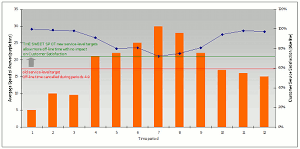
The consequences of providing poor customer service are well known. What is less obvious perhaps is the importance of providing on-target customer experience as a means to boost profitability — in other words, neither underdelivering nor overdelivering in order to secure optimal customer satisfaction at an optimal cost.
A great brand experience and high satisfaction with the customer experience are clearly desired outcomes, but by their nature can be costly to deliver, and the law of diminishing returns highlights that at some point this investment will fail to deliver significant results.
So, contact centers are faced with two fundamental questions: “How much investment is enough?” and “Does this target change over time?” Addressing the first question and dynamically reviewing the second will ensure that centers attain this sweet spot of customer delivery: targeting levels of service to align closely to the point where the customer is indifferent about
Identifying the right questions for customers, surveying them, and linking the responses back to something like a Net Promoter Score customer loyalty metric will help to identify that sweet spot — and where you need to focus your efforts and investments.
So, where can you start to identify those areas for improvement?
Average Speed of Answer
It’s common knowledge that contact centers have traditionally set average speed of answer (ASA) service levels at 90 percent at 10 seconds, or 80 percent at 20 seconds — but these targets have been chosen rather arbitrarily, and contact center operations leaders often become fixated on meeting them.
In doing this, there is the potential to negatively impact the overall business. For example, to put more agents on the phones to speed up call answer times, important initiatives like coaching and training likely take a back seat. More significantly, in the longer term, this could result in decreased agent morale and motivation — which, in turn, could easily trickle into the customer interactions and resulting customer experiences.
By capturing a “real-time” view of customer satisfaction based on the time taken to answer, you can actually change the game. For example, by using customer surveys and the insight gleaned from those, and overlaying this with data from real-time ASA stats, it is possible to identify where exactly you need to fall in terms of ASA to determine the necessary range and the threshold you can’t drop below — in essence, your sweet spot. You can define a service level based on an understanding of exactly how it impacts your customers’ satisfaction, rather than setting arbitrary targets.
Consider the following example that helped a leading contact center organization to reconsider how they defined service level targets.
By focusing performance on customer outcomes rather than outdated efficiency metrics, you can actually reduce service level targets.
With the extra time and resources saved, you could invest in more training and coaching to improve agent knowledge and call-handling skills, and minimize the cancellation of offline time. This results in a win-win scenario: Overall customer satisfaction levels can be increased; you can focus more on cross-selling to drive additional revenue; and staff satisfaction will likely increase because you are canceling less offline time and offering more coaching time and one-on-one support.
Agent Efficiency, First Contact Resolution and Customer Satisfaction
Setting targets for average handling time (AHT) and offline coaching in order to maximize first call resolution (FCR) and customer satisfaction (CSAT) while minimizing operating costs is a business challenge faced by all contact center operations. Set the AHT target too low, and you can answer a lot more calls, but your customers are likely to be very dissatisfied with the service they receive — agents will rush calls, sound uncaring and not necessarily address the customer’s query.
On the other hand, relax AHT targets and agents will have much more time to answer customer queries, but the cost of your operation may start to become excessive. There is a balance — or a sweet spot — where operational costs in terms of AHT and offline time are balanced with CSAT and FCR.
By specifically measuring CSAT with each agent’s performance, any additional investment in coaching or increased AHT target can be compared against the impact it has on CSAT. By introducing satisfaction survey tools that enable you to measure, analyze and report customer satisfaction at the agent level, it is possible to find the sweet spot of agent performance.
Beyond the Phone
While call service levels may be some of the first things that come to mind, it is critical to also consider the Web channel and issues such as website usability, as in-bound contacts regarding frustrations with a website experience fall squarely on the contact center manager’s shoulders and can be more costly to resolve.
The proactive use of customer surveys to understand what’s most important to customers with regard to the website will help support a positive experience with the site and, by association, the company as a whole. This investment is money well spent if it helps to reduce in-bound calls into your center because of a negative website experience, for example, as a result of a faulty or poorly designed e-commerce system.
Importantly, though, the learnings from these surveys must be structured so as to prioritize and quantify customer preferences so that Web investments might be linked to sweet spot needs and not purely to a wish list that doesn’t create value for the customer or the provider.
Is Today the Same as Yesterday?
The above are just a few examples of how traditional ways of thinking about service and service levels can — and should — be changed. Of course, the environment in which we all operate presents its own challenges. What was acceptable customer service last month may not be appropriate this month. Consider self-service or digital-only channels. Clearly, these represent a reduced level of customer service, but they carry lower potential costs that can be passed back.
The sweet spot in customer delivery can be a moving target, often moving faster in times of economic uncertainty. Contact center executives need to constantly review service levels and the information they are gathering from customers to make sure they are appropriately aligned.
By using things like Voice of the Customer and customer survey satisfaction results, and constantly evaluating service levels to ensure they are suitable, contact center executives can set in motion evolutionary changes in how they manage their centers to better drive operational improvement, efficiencies and cost reductions — while not sacrificing the customer experience at the same time.
It is equally important to understand the economics of the customer experience: the relationship between satisfaction and profit and the marginal cost of delivering higher or more customized levels of service. These internal factors, brought together with external customer insight, collectively inform the decisions that optimize delivery of an on-target customer experience.
John Hall is managing director and Jaime Scott is head of global quality atVertex.













































Social CRM
See all Social CRM